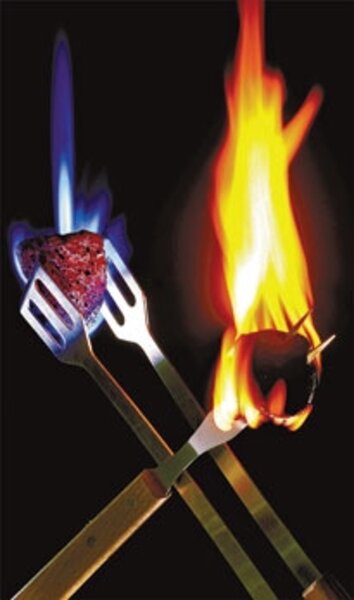Grilling with gas or charcoal: What’s better for the environment?
Loading...
Having a backyard barbecue and wondering whether to use charcoal or propane? A new study in the journal Environmental Impact Assessment Review compares the two and finds that propane, a fossil fuel, is better for the environment than charcoal, a biofuel. Propane, the author says, has a carbon footprint just above one-third of charcoal’s.
It’s a question of efficiency in the manufacturing process (how much fuel it takes to make the fuel). Charcoal is made by slow-burning wood in a kiln. Only 20 to 35 percent of the wood that goes into creating charcoal actually becomes charcoal. The rest goes up the chimney. Propane, on the other hand, has a much greater yield. More than 90 percent of the fuel used in making propane becomes liquid gas.
Then there’s the question of efficiency at the user’s end – your grill. Gas-burning stoves turn on and off quickly, so users can easily control how much is burned and how much CO2 gets released. By comparison, charcoal-burning stoves aren’t as easily stopped or started. And they also require fire lighters, an additional fuel with its own CO2 footprint.
Also in eco-news and discoveries:
Wildlife migrating farther north
Increasing temperatures in recent decades, especially rising low temperatures, are pushing wildlife northward in the northern Great Lakes region, a new study finds. And at the same time, as colder-loving species move north, more southerly species are moving in.
Writing in the June issue of Global Change Biology, scientists say that of nine mammal species studied, five – woodland deer mice, woodland jumping mice, least chipmunks, northern flying squirrels, and southern red-backed voles – have declined in parts of Michigan.
Four southerly species – white-footed mice, southern flying squirrels, eastern chipmunks, and common opossums – have extended their range – and not by just a few miles. The mice and flying squirrels, for example, have moved 140 miles north compared with where they were in 1980.
What the shifting critters may mean in the long term is up for debate.
But the authors point out that these small but plentiful mammals play large roles in their ecosystems. They disperse seed and fungus (some fungi are important for tree- root health). They also control insect populations that might otherwise decimate trees. And they serve as prey for a host of birds, other mammals, and snakes.





